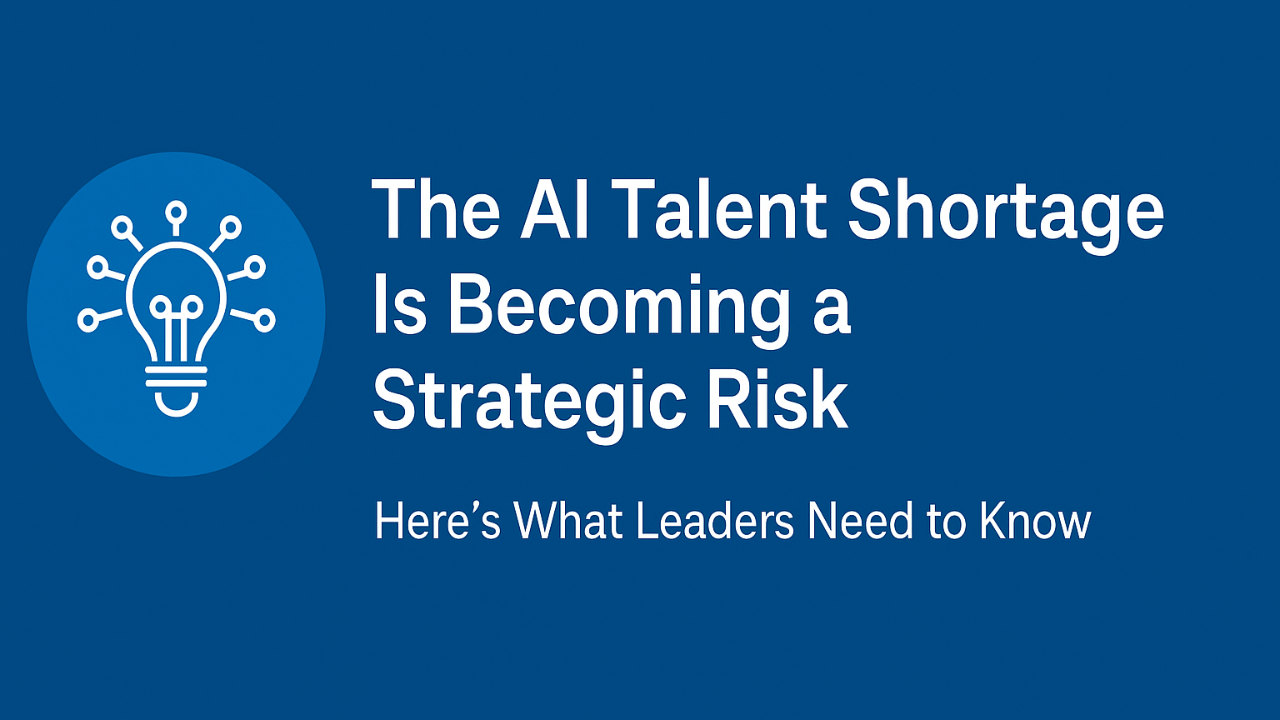The AI Talent Shortage Has Become a Strategic Business Risk And Most Organizations Are Not Ready

Every executive I speak with wants to “scale AI,” but there is one hard truth we can’t ignore:
The demand for AI-skilled talent now exceeds the supply by more than 3.2×.
That means for every one qualified AI professional, there are more than three open roles competing for the same person.
To make this clearer:
If the market has 10,000 AI-ready workers, organizations are trying to fill more than 32,000 AI roles.
➡️ There are simply not enough people to do the work.
It’s no surprise, then, that over 50% of IT leaders report their AI initiatives are slowed or stalled because they cannot hire people with the right mix of machine learning, data engineering, MLOps, AI governance, and domain expertise.
And this shortage is no longer just about data scientists.
The gap is hitting across the board:
- AI/ML engineers
- MLOps and platform engineers
- Data pipeline and orchestration specialists
- AI governance + risk + compliance
- Human-AI interaction designers
- Cybersecurity talent with AI knowledge
- Prompt engineering + agent workflow designers
The workforce requirements for AI have evolved faster than most organizations’ ability to build or hire for them.
Why This Shortage Is So Severe
1️⃣ AI adoption exploded faster than talent development
Investment is skyrocketing across various sectors, including healthcare, finance, manufacturing, logistics, and government, but the talent pipeline has not kept pace.
2️⃣ The skills required for AI work are changing in real time
Two years ago, nobody was hiring for “AI Safety,” “RAG engineers,” or “agentic workflow designers.”
Now these roles are essential to AI maturity.
3️⃣ Regulated industries need deeper expertise
Healthcare, finance, insurance, and public sector teams must hire people who understand:
NIST AI RMF, ISO 42001, HIPAA, PHI governance, model provenance, bias controls, audit readiness…
This is a specialized skill set, and those workers are even harder to find.
4️⃣ AI governance is no longer optional
Executives are realizing that AI is not just a technical capability; it’s a risk domain.
This means hiring needs to span security, compliance, privacy, audit, and human-in-the-loop oversight.
5️⃣ Smaller organizations can’t compete with Big Tech's compensation
Top AI talent receives offers that include:
- High six-figure salaries
- Remote-first flexibility
- Equity packages
- Custom career paths
This leaves mid-market organizations at a serious disadvantage.
📉 What This Means for Leaders
When the talent gap is 3.2×, the consequences ripple across the entire organization:
- AI projects get delayed or abandoned
- Governance and safety controls lag behind deployment
- Workloads expand faster than teams can scale
- Cyber risk increases due to understaffed AI-related roles
- Technical debt accumulates in AI pipelines
- Compliance exposure grows (especially in regulated industries)
- Productivity gains remain theoretical instead of operational
The AI talent shortage is no longer a hiring problem.
It is a governance problem.
It is a risk problem.
And it is becoming a business continuity problem.
What Leading Organizations Are Doing Differently
The strongest CIOs, CISOs, and Chief Data/AI Officers are shifting from “we need to
hire talent” to “we need to build AI capability systems.”
They are:
- Upskilling internal teams instead of relying exclusively on outside hiring
Teaching existing engineers how to work with LLMs, pipelines, and MLOps reduces talent dependency.
- Embedding AI governance into existing GRC + DevSecOps workflows
This ensures responsible AI is part of the regular business rhythm, not a bolt-on.
- Creating cross-functional AI working groups
Bringing together Security, Compliance, Data, Engineering, Legal, and Operations.
- Using hybrid models: internal talent + external advisory support
Organizations don’t have to do everything alone — especially in high-risk, high-complexity AI environments.
- Treating AI readiness as a strategic capability, not a side project
AI maturity is becoming a competitive advantage.
Those who invest early will lead.
The Opportunity Hiding Inside the Talent Shortage
If talent is scarce, companies that develop a clear AI governance structure, strong internal reskilling pathways, and repeatable execution frameworks will outperform others.
Because the competitive advantage will come from:
➡️ Who can adopt AI safely
➡️ Who can operationalize it at scale
➡️ Who can govern it consistently
➡️ Who can ship value faster than the market
Organizations that get this right will not be limited by the 3.2× talent gap — they’ll simply out-execute competitors who rely solely on external hiring.
👋 Final Thought
The AI talent shortage is real.
The 3.2× gap is widening.
Most organizations, however, are not prepared for the implications.
However, leaders who establish strong foundations in AI governance, responsible deployment, and internal capability development can transform this global constraint into a strategic advantage.
If your organization is working through AI readiness, governance, risk alignment, or workforce planning, I welcome the opportunity to assist you on this AI Governance Compliance journey.
We hate SPAM. We will never sell your information, for any reason.

